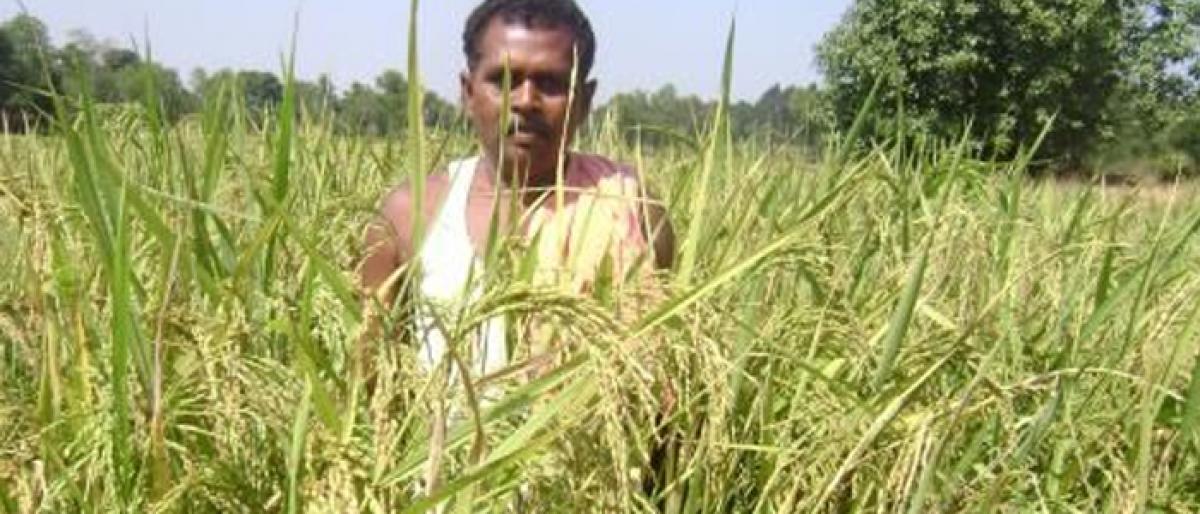Live
- Aaditya Thackeray Calls For EOW Probe Into Mumbai's Rs 7,000 Crore Road Project
- Omar Abdullah Urges Congress To Earn INDIA Bloc Leadership Role
- Yogi Adityanath Contrasts Historical And Modern Treatment Of Workers In India
- Historic Temple In Sambhal Reopens After 46-Year Closure Following 1978 Riots
- Officials directed to work for deeper reach of guarantees
- Delay In 'One Nation, One Election' Bills Introduction Announced
- Exhilarating ‘Benchmark’ of Venkat Changavalli
- Development activities worth `30 cr launched in Puthalapattu constituency
- Allegations against KTR baseless: BRS leader
- Megastar Chiranjeevi to Visit Allu Arjun’s Residence at 12 PM Today
Just In

The Cabinet has announced higher MSPs in recognition of the economic problems of farmers The economic and ecological health of agriculture is not good as is clear from the massive protests by kisan organisations and the reoccurrence of farmer suicides The two main demands of the farmers movement are for loan waiver and remunerative prices
The Cabinet has announced higher MSPs in recognition of the economic problems of farmers. The economic and ecological health of agriculture is not good as is clear from the massive protests by kisan organisations and the re-occurrence of farmer suicides. The two main demands of the farmer’s movement are for loan waiver and remunerative prices.
The monsoon and the market play an important role in the profitability and stability of income in agriculture. The government has taken steps to improve crop insurance but the coverage and performance are still far from satisfactory and risks are still high leading to demand for higher price and credit reform.
In terms of marketing support which farmers need, the policy should have three integrated components:
i) A minimum support price or MSP based on the formula of C2 + 50%
ii) A favourable procurement policy to ensure that farmers do receive the MSP
iii) Increasing consumption through the effective implementation of the Food Security Act, school noon meal programmes, etc.
The announcement has the following implications:
(i) The MSP announced is higher in absolute terms but below the recommended level. For example, the MSP of common paddy has been hiked from Rs 1,550 to Rs 1,750 per quintal. Taking the C2 cost of last year (2017-18) and assuming a 3.6 per cent rise in input costs based on the input cost index used by CACP, the estimated C2 cost for this year (2018-19) is Rs 1524. So, the new MSP is C2+15%, not C2+50%. In the case of ragi, the new MSP is C2+20%.
Similarly, for moong, the MSP has been raised from Rs 5575 to Rs 6975, so it is now C2+19%;
(ii) Higher MSPs are welcome but there is inadequate public procurement at MSP, except in the case of wheat and rice. This is clear from the experience of farmers who cultivated more pulses, on the expectation of procurement but were let down by a crash in market prices. Indeed, for many crops including urad, tur, maize, groundnut, soyabean, bajra, rapeseed and mustard, the weighted average mandi price was below the corresponding MSP before the monsoon.
(iii) Other steps such as those recommended by the National Commission on Farmers which will help to improve both income stability as well as total income from farming will have to be introduced. Appropriate measures are also needed to ensure that groundwater over-exploitation, and other eco-destructive activities, are limited.
The minimum support price sought by farmers in their ongoing nationwide strike has brought back to focus the recommendations of the report submitted by the National Commission on Farmers headed by Professor MS Swaminathan over 10 years ago in 2007.
Stressing on the importance of the minimum support price (MSP) suggested by him, calculated as the total cost of production (including paid-out cost, imputed value of family labour, and imputed rent and interest on owned land and capital) plus 50 per cent (C2 + 50%), Professor Swaminathan says it is to the benefit of all to support the agitating farmers in their demands.
“The farm crisis is at long last attracting both public and political attention. A National Policy for Farmers was formulated by the National Commission on Farmers chaired by me in 2007. That Draft Policy placed special stress on enhancing the income of farmers. A formula was suggested for determining the minimum support price for farm produce. Although the report is now over 10 years old, no action has been taken on its implementation particularly with reference to the economics of farming.”
Pointing to the demand from farmers for a loan waiver, Professor Swaminathan explains that enhancement of farmers’ income is the only way to help them come out of debt traps and poverty. “The monsoon and the market are two of the major determinants of farmers’ well-being. Today the monsoon is uncertain and extreme events like drought and floods are becoming more frequent. Similarly the market in most cases does not help farmers come out of the debt and poverty traps. This is why there is more demand for loan waivers.”
Says Professor Swaminathan: “The time has come for the National Policy for Farmers, which represented the voice of the farming community, to be examined and acted upon.” Exhorting the public to fully support the farmers to survive economically, Professor Swaminathan says, “If farming goes wrong, nothing else will have a chance to go right in a predominantly agricultural country like ours.” In particular, he suggests that paying attention to women farmers and peri-urban agriculture would make a large difference to the future of agriculture.

© 2024 Hyderabad Media House Limited/The Hans India. All rights reserved. Powered by hocalwire.com







